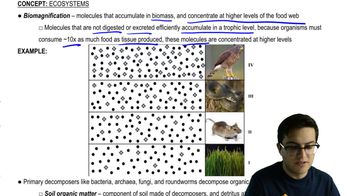Table of contents
- 1. Introduction to Biology2h 40m
- 2. Chemistry3h 40m
- 3. Water1h 26m
- 4. Biomolecules2h 23m
- 5. Cell Components2h 26m
- 6. The Membrane2h 31m
- 7. Energy and Metabolism2h 0m
- 8. Respiration2h 40m
- 9. Photosynthesis2h 49m
- 10. Cell Signaling59m
- 11. Cell Division2h 47m
- 12. Meiosis2h 0m
- 13. Mendelian Genetics4h 41m
- Introduction to Mendel's Experiments7m
- Genotype vs. Phenotype17m
- Punnett Squares13m
- Mendel's Experiments26m
- Mendel's Laws18m
- Monohybrid Crosses16m
- Test Crosses14m
- Dihybrid Crosses20m
- Punnett Square Probability26m
- Incomplete Dominance vs. Codominance20m
- Epistasis7m
- Non-Mendelian Genetics12m
- Pedigrees6m
- Autosomal Inheritance21m
- Sex-Linked Inheritance43m
- X-Inactivation9m
- 14. DNA Synthesis2h 27m
- 15. Gene Expression3h 20m
- 16. Regulation of Expression3h 31m
- Introduction to Regulation of Gene Expression13m
- Prokaryotic Gene Regulation via Operons27m
- The Lac Operon21m
- Glucose's Impact on Lac Operon25m
- The Trp Operon20m
- Review of the Lac Operon & Trp Operon11m
- Introduction to Eukaryotic Gene Regulation9m
- Eukaryotic Chromatin Modifications16m
- Eukaryotic Transcriptional Control22m
- Eukaryotic Post-Transcriptional Regulation28m
- Eukaryotic Post-Translational Regulation13m
- 17. Viruses37m
- 18. Biotechnology2h 58m
- 19. Genomics17m
- 20. Development1h 5m
- 21. Evolution3h 1m
- 22. Evolution of Populations3h 52m
- 23. Speciation1h 37m
- 24. History of Life on Earth2h 6m
- 25. Phylogeny2h 31m
- 26. Prokaryotes4h 59m
- 27. Protists1h 12m
- 28. Plants1h 22m
- 29. Fungi36m
- 30. Overview of Animals34m
- 31. Invertebrates1h 2m
- 32. Vertebrates50m
- 33. Plant Anatomy1h 3m
- 34. Vascular Plant Transport2m
- 35. Soil37m
- 36. Plant Reproduction47m
- 37. Plant Sensation and Response1h 9m
- 38. Animal Form and Function1h 19m
- 39. Digestive System10m
- 40. Circulatory System1h 57m
- 41. Immune System1h 12m
- 42. Osmoregulation and Excretion50m
- 43. Endocrine System4m
- 44. Animal Reproduction2m
- 45. Nervous System55m
- 46. Sensory Systems46m
- 47. Muscle Systems23m
- 48. Ecology3h 11m
- Introduction to Ecology20m
- Biogeography14m
- Earth's Climate Patterns50m
- Introduction to Terrestrial Biomes10m
- Terrestrial Biomes: Near Equator13m
- Terrestrial Biomes: Temperate Regions10m
- Terrestrial Biomes: Northern Regions15m
- Introduction to Aquatic Biomes27m
- Freshwater Aquatic Biomes14m
- Marine Aquatic Biomes13m
- 49. Animal Behavior28m
- 50. Population Ecology3h 41m
- Introduction to Population Ecology28m
- Population Sampling Methods23m
- Life History12m
- Population Demography17m
- Factors Limiting Population Growth14m
- Introduction to Population Growth Models22m
- Linear Population Growth6m
- Exponential Population Growth29m
- Logistic Population Growth32m
- r/K Selection10m
- The Human Population22m
- 51. Community Ecology2h 46m
- Introduction to Community Ecology2m
- Introduction to Community Interactions9m
- Community Interactions: Competition (-/-)38m
- Community Interactions: Exploitation (+/-)23m
- Community Interactions: Mutualism (+/+) & Commensalism (+/0)9m
- Community Structure35m
- Community Dynamics26m
- Geographic Impact on Communities21m
- 52. Ecosystems2h 36m
- 53. Conservation Biology24m
48. Ecology
Introduction to Ecology
Problem 3b
Textbook Question
Which of the following groups is (are) absolutely essential to the functioning of an ecosystem? a. producers b. producers and herbivores c. producers, herbivores, and carnivores d. producers and decomposers
 Verified step by step guidance
Verified step by step guidance1
Identify the role of producers in an ecosystem: Producers, such as plants and algae, are organisms that can produce their own food through photosynthesis, converting sunlight into chemical energy.
Consider the role of herbivores: Herbivores are organisms that consume producers. They are important for transferring energy from producers to higher trophic levels but are not the primary source of energy production.
Analyze the role of carnivores: Carnivores consume herbivores and other carnivores. They help control the population of other trophic levels but do not contribute directly to primary production.
Examine the role of decomposers: Decomposers, such as bacteria and fungi, break down dead organic matter, recycling nutrients back into the ecosystem, which are essential for the growth of producers.
Determine which groups are essential: Assess which of the groups are absolutely necessary for the basic functioning of an ecosystem, focusing on energy production and nutrient cycling.
Recommended similar problem, with video answer:
 Verified Solution
Verified SolutionThis video solution was recommended by our tutors as helpful for the problem above
Video duration:
1mPlay a video:
Was this helpful?
Key Concepts
Here are the essential concepts you must grasp in order to answer the question correctly.
Producers
Producers, or autotrophs, are organisms that can create their own food through photosynthesis or chemosynthesis. They form the base of the food chain, converting solar energy into chemical energy, which is then available to other organisms in the ecosystem. Examples include plants, algae, and some bacteria.
Recommended video:
Guided course

Producers and Consumers
Decomposers
Decomposers, such as fungi and bacteria, play a critical role in ecosystems by breaking down dead organic matter and recycling nutrients back into the soil. This process is essential for maintaining soil health and fertility, allowing producers to thrive. Without decomposers, ecosystems would accumulate waste and nutrients would become locked in dead material.
Recommended video:
Guided course

Biomagnification and Decomposers
Trophic Levels
Trophic levels represent the hierarchical positions of organisms in an ecosystem based on their feeding relationships. Producers occupy the first level, followed by herbivores (primary consumers) and carnivores (secondary and tertiary consumers). Understanding these levels is crucial for analyzing energy flow and nutrient cycling within ecosystems.
Recommended video:
Guided course

Trophic Structure

 2:54m
2:54mWatch next
Master What is Ecology? with a bite sized video explanation from Jason Amores Sumpter
Start learningRelated Videos
Related Practice































































































